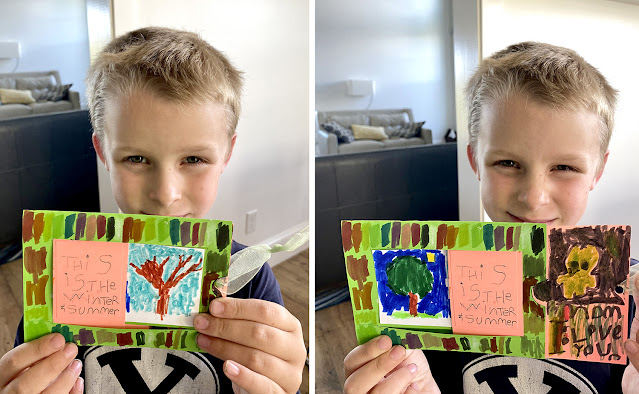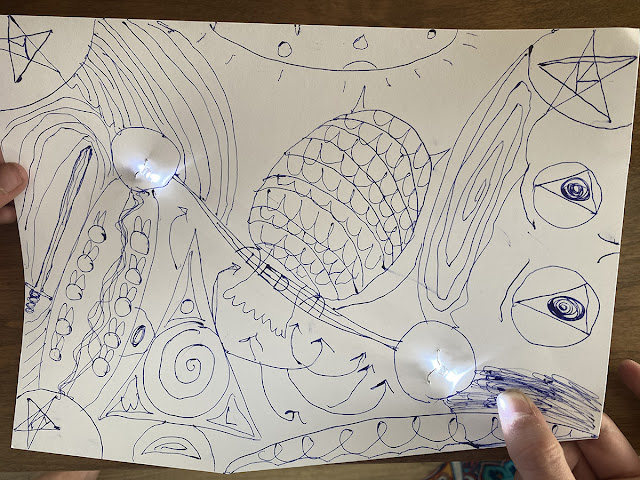This year has been a funny one! It started out with the birth of our sweet baby Clementine—on the first day of school! (Public school, anyway.) We had been banking up school time during the previous year and summer so I could feel fine about taking a nice long break for the baby. When we did start school again, I decided to start with something I could put together easily and without a ton of preparation time, so I chose to do a Music History Unit.
I majored in Music in college, so I have a lot of resources—CDs and textbooks, and a pretty good grasp of the overall scope of Music History, so I hoped all I'd need to do was request some library books and find good recordings of the pieces I wanted to discuss.
It ended up being a MONSTER Unit, over twelve weeks long, because we first studied Sound—then Instruments—then Musical Eras and Composers—then Musical Genres—and even got to ballet and opera and movie music by the end. It was pretty comprehensive! And it was lots of fun. It took a bit longer than I'd planned, but it was, as I'd hoped, just the right thing for a unit right after having a baby: lots of opportunities for just sitting in my bed and listening and talking, and not too many heavily involved crafts or projects.
A few of the activities we did do are on my Pinterest page, here: https://www.pinterest.com/marilynnielson/music-unit/
I can't even possibly link to all the videos we watched—basically I chose representative music from each era and highlighted composers, and we listened to sometimes several versions of one piece. I pulled from my faithful old Norton Scores from college, but also other music in our collection, or Apple Music. We also watched lots of video recordings because it's so instructive to SEE the music being played. (It would have been great to go to more concerts during this unit, but there were still lots of Covid closures plus the aforementioned new baby, so we didn't really get to.)
Anyway, I went through my YouTube History and tried to pull out videos that we liked especially, but I'm sure I missed a bunch. But I'll link some of them here:
• What does a vibraphone sound like?: https://www.youtube.com/watch?v=BkBu7Om6Bd4 (there were a whole bunch of these instrument/timbre videos on the Utah Symphony page and they were quite good; you can find the rest here:
• Other videos about each instrument in the orchestra: https://www.youtube.com/playlist?list=PLALV7z7CDQ7yCWoOvUK4mOMAE4ub_h0TG
• How vinyl records are made: https://www.youtube.com/watch?v=Eq5EDXNe-HQ&t=131s
• History of recorded sound https://www.youtube.com/watch?v=5Mb6y_s1QQc&t=220s
• How do microphones work? https://www.youtube.com/watch?v=d_crXXbuEKE
• Can you hear me now?: How microphones work https://www.youtube.com/watch?v=1MaH5V0UomE
• Sound and waves demonstrations https://www.youtube.com/watch?v=De1J2V0Cta4
• Electron microscope and the path of the needle in a vinyl LP: https://www.youtube.com/watch?v=yUDclkJpMfo
• That Sound and Percussion Unit is summarized in these posts, and goodness! It seems like it happened recently, but look at these tiny children!
Benjamin Britten's "A Young Person's Guide to the Orchestra" (I love this and there are many good recordings of it) https://www.youtube.com/watch?v=IMGqdUqPnmo
• A very dramatic (and shortened) "Bolero," which the children liked https://www.youtube.com/watch?v=LwLABSm0yYc
• Peter and the Wolf—I mostly chose this because it had some storybook-ish pictures, but there are probably better recordings. Peter and the Wolf is always good, though. https://www.youtube.com/watch?v=9ueGfjBKbiE&t=1s
• Demonstration of different trumpet mutes—so interesting! https://www.youtube.com/watch?v=K9F5DaxIUcQ&t=19s
• This is fun. "Tuba Tiger Rag" by the Canadian Brass: https://www.youtube.com/watch?v=o7IraO35qu8
• Demonstration of a celeste: https://www.youtube.com/watch?v=Aw7HAyq54rw&t=4s
• This one is super cool—"How do vocal cords work when you sing?" https://www.youtube.com/watch?v=P2pLJfWUjc8
• A little advanced. Wish I could've found a simpler explanation. "What is a fugue?" https://www.youtube.com/watch?v=vAFETgpt9PA&t=157s
• Royal Fireworks Music, with fireworks: https://www.youtube.com/watch?v=ZuG1t2smdCQ
• La Boutique Fantastique, a fun short ballet https://www.youtube.com/watch?v=E_D3JHR8emE
• Dance of the Cygnets, from Swan Lake. The girls were dancing in Swan Lake with their ballet studio for this year, so it was fun to watch a bunch of clips from it. https://www.youtube.com/watch?v=0GsajWIF3ws
• Weird opera by Shostakovich, "The Nose." I don't know why we watched these strange tap-dancing noses, but we did. https://www.youtube.com/watch?v=YotMwwixPsw
• The importance of instrumentation: https://www.youtube.com/watch?v=BEpJZDUwOTI
• Understanding the leitmotif: https://www.youtube.com/watch?v=bR2EobBG9wQ
• A couple fun cartoons that use classical music: "Pink Panther in Pink, Plunk, Plink" https://www.youtube.com/watch?v=xiA6qe5S2wU and "Tom and Jerry: The Cat Concerto" https://www.youtube.com/watch?v=uKZgi06fVsk
• Star Wars Leitmotifs https://www.youtube.com/watch?v=rExbps1JofI
• A history of minimalism https://www.youtube.com/watch?v=k3VUeNyGcrQ&t=464s
• Clapping Music—Steve Reich https://www.youtube.com/watch?v=YPU5XrmORCQ
• When film music is funny https://www.youtube.com/watch?v=_1Lpqk_3ero
We ended up covering Jazz, Opera, and Ballet during this unit, and each of those could have been a whole unit in themselves—so we just did brief overviews. It would be fun to return to any of them and go more in depth!
We had a couple of great guest speakers—my neighbor taught us about Jazz (she majored in Vocal Jazz in college) and my cousin Heidi gave us a workshop on the pipe organ. Both of those classes were really great. Here are some pictures from the Organ class:
These make me nostalgic because we had Abe with us on this field trip! He was the one taking the pictures. It seems so long ago!




















































